Inversion – Preview
by Edward
|
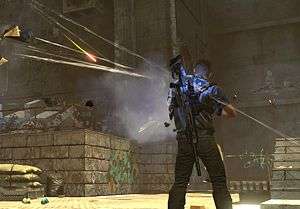 Over the last two years, I’ve slowly found myself becoming more disillusioned with the first and third person shooter genres. Gears of War was revolutionary for its time but, much like Call of Duty after it, its success has spawned countless ‘me-too’ affairs that fail to captivate as much as Soap and Fenix ever could. After reviewing the indeterminable dross that was Deep Black: Reloaded, I was prepared to hang up my controller and abandon the genre for good, lest I waste any more of my life hiding behind chest-high walls waiting for my health to finish regenerating. Then something amazing happened that made me take my controller out of the noose and become excited for the genre all over again. That something is Inversion.
Over the last two years, I’ve slowly found myself becoming more disillusioned with the first and third person shooter genres. Gears of War was revolutionary for its time but, much like Call of Duty after it, its success has spawned countless ‘me-too’ affairs that fail to captivate as much as Soap and Fenix ever could. After reviewing the indeterminable dross that was Deep Black: Reloaded, I was prepared to hang up my controller and abandon the genre for good, lest I waste any more of my life hiding behind chest-high walls waiting for my health to finish regenerating. Then something amazing happened that made me take my controller out of the noose and become excited for the genre all over again. That something is Inversion.
For anyone who hasn’t read Mark’s preview of the game from Gamescom, Inversion’s twist on the third-person shooter is the ability to let you manipulate and alter gravity. The story starts with your protagonist having seen better days, unless his days usually involve being tied up, bloodied, bruised, and with his imminent execution in front of people using broken dialect. Cue a voice-over tied with several playable flashbacks presented in monochrome, allowing you to get a small glimpse into the gameplay that lies ahead, as well as your apparent fate. As things look about to take a turn for the worse the core game begins, placing you several weeks in the past as your protagonist Davis Russel and his friend (or your co-op partner) Leo Delgado discuss the former’s plan to take a break from policing the streets in order to give his daughter her birthday present.
Their conversation is cut short when chaos breaks out and our heroes resolve to check it out, hefty shotguns in hand, and are confronted by strange men mowing down the civilian population. Cue you trying to take down your foes whilst avoiding gunning down the fleeing bystanders, and expect an earful if you accidentally shoot one of them too. As the city begins collapsing around them, the duo make haste to Davis’ apartment in order to save his family, and let’s just say there wouldn’t be much to the rest of the game if the plan went off without a hitch. The action restarts several weeks later, as Leo and Davis have been locked up in an internment camp and forced to perform manual labour by the invading force, now named the Lutadores. Our heroes’ luck takes a turn for the better as they’re forced to explore some of the nearby tunnels, and are both given a shiny new grav-link to play with.
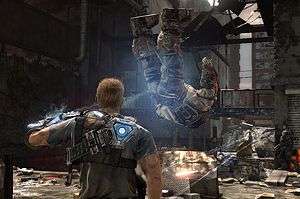 The pitfall of games forced to walk in the footsteps of any particular genre is that attempts to differentiate often feel shoe-horned or gimmicky and, if not done correctly, can ruin the entire experience. Worse still is when ideas seem to have been retrofitted without considering how they’ll affect the rest of the game, akin to someone creating a three-armed mutant without thinking ahead to modify any t-shirts until it came time to clothe them. What makes Inversion stand out above the rest is that the game feels like the idea of using gravity was there from the beginning, and this is evident from the moment you’re first allowed to progress, grav-links in tow.
The pitfall of games forced to walk in the footsteps of any particular genre is that attempts to differentiate often feel shoe-horned or gimmicky and, if not done correctly, can ruin the entire experience. Worse still is when ideas seem to have been retrofitted without considering how they’ll affect the rest of the game, akin to someone creating a three-armed mutant without thinking ahead to modify any t-shirts until it came time to clothe them. What makes Inversion stand out above the rest is that the game feels like the idea of using gravity was there from the beginning, and this is evident from the moment you’re first allowed to progress, grav-links in tow.
Every environment seems filled to the brim with objects that can be manipulated by the grav-links in one way or another; objects you can send floating up in the air, crashing back down to earth or flying across the map. There were hints towards how interactive the environments were in the opening gunfights, as areas of cover would shatter and break apart under gunfire, but once gravity manipulation comes into play all bets are off. Enemy cover can be compromised with the simple press of a button, causing the flimsy barrier and the unfortunate Lutadore behind it to be hurled into the air and left completely exposed. Objects can be lifted in a similar manner then hurled across the screen at your foes, giving you a great incentive to conserve ammo and create mayhem, or even used as temporary cover as you move to a more secure location. As I progressed throughout the single player I was reminded of all the games that boast destructible environments, only for it to result in a couple of set pieces just so they could put a tick on the back of the box. Inversion is not one of those games, and I couldn’t help but let my jaw drop a little during the boss battle I ended my single player experience on, when I saw that every piece of cover had been tattered or broken in some way.
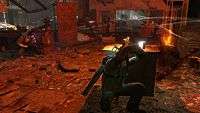 |
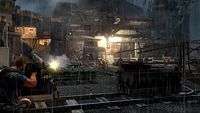 |
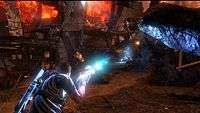 |
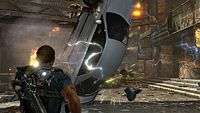 |
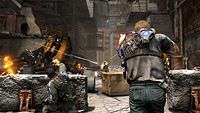 |
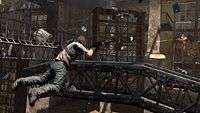 |
The other reason you can tell gravity manipulation was there from the beginning is also the same reason why I started to fall for the game long before my time with it came to an end: the flow. Simply put, Inversion’s campaign mode is so expertly crafted that everything feels seamless, from the grim opening to running through a slowly collapsing apartment block and sneaking out of a makeshift prison as you slowly start to lose consciousness from blood loss, Inversion is a game that seems to never let up and always has something new and awesome to show you. Gameplay elements are introduced gradually and, after a short introduction with each of your grav-link powers, you’re left to figure out how best to employ these powers at your own discretion. Even your basis melee attack manages to feel as quick and brutal as every other tool in your arsenal. The pace feels fast yet consistent but without ever rushing you, cut-scenes are intertwined with the action without noticeable loading times, and it all makes for something that becomes increasingly more difficult to put down the more you play.
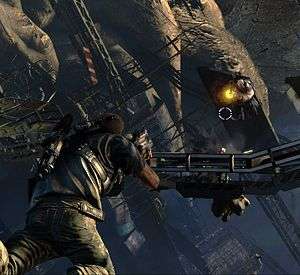 In comparison to other games in the genre where the pace slows to a crawl as the developers thought “difficulty” meant “put more enemies in the room than you can feasibly deal with and make them bullet sponges”, Inversion is a breath of fresh air. The two hours I spent with the single player were amazingly invigorating and I’m sure that the experience will continue to pay dividends beyond where I finished, whether I continued by myself or with a friend. While there is an option to have a friend join in your adventures, your AI partner is much more competent than you’d expect him to be, with him intelligently taking cover, using gravity powers himself, attacking targets you may not be, and not collapsing every couple of minutes in need of rescue. Regardless of whether you tackle the adventure solo or with your friends, the flow of the campaign is so masterfully manipulated that you’ll be thinking with gravity in no time.
In comparison to other games in the genre where the pace slows to a crawl as the developers thought “difficulty” meant “put more enemies in the room than you can feasibly deal with and make them bullet sponges”, Inversion is a breath of fresh air. The two hours I spent with the single player were amazingly invigorating and I’m sure that the experience will continue to pay dividends beyond where I finished, whether I continued by myself or with a friend. While there is an option to have a friend join in your adventures, your AI partner is much more competent than you’d expect him to be, with him intelligently taking cover, using gravity powers himself, attacking targets you may not be, and not collapsing every couple of minutes in need of rescue. Regardless of whether you tackle the adventure solo or with your friends, the flow of the campaign is so masterfully manipulated that you’ll be thinking with gravity in no time.
Once you’re done with the campaign and need more gravity-based shenanigans in your life, you can always make your way to the multi-player mode. After dabbling with the customisation tools for a while, the time came to play a good old fashioned death-match, and even though there were several experienced players in the midst, it managed to be a tense, unpredictable affair where mastery of gravity powers was all-important. One thing I did notice was that people employing the blue gravity power that lifts everything in the air seemed to do slightly better than those using the red gravity that makes everything heavier, as the red gravity needed a more accurate blast while the blue left the affected player exposed for longer. Regardless, battles didn’t rely on the use of powers to define a clear winner or loser in the sense of whoever fired first won, but they acted as a catalyst to each fight and emphasised the use of quick-thinking strategy over run and gun action.
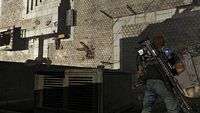 |
 |
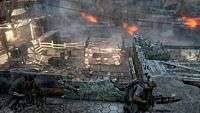 |
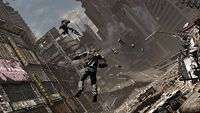 |
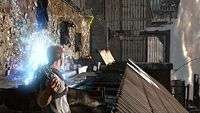 |
 |
The other mode we were shown was referred to as “Hourglass”; players are split into either the red or blue team, with your team colour reflecting the only gravity power your character is allowed to use. One team starts out as the defending side, and must make sure to keep their capture point safe until the hourglass on the side of the screen finally lands at their team’s emblem. So far, so familiar, but the twist is that if the attacking side successfully take the point, then the gravity is turned literally upside down and the fight continues on what was formally the ceiling. It’s a well-employed twist, and helps shake up the battlefield considerably, as you must quickly accustom yourself to your new surroundings and make haste to complete your objective if you want to turn the tide back in your favour. Hourglass is a great mode, and I’d personally rate it as a much better experience than the death-match, as it captures the feel of Inversion a lot more accurately and, like the campaign before it, emphasises what can be done when you throw the ability to change gravity into the mix.
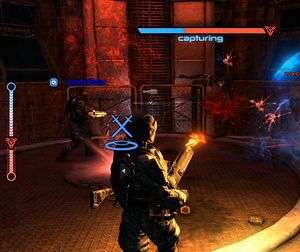 When my time with Inversion finished, I was left excited, and as I write this preview and relive the experience, I’m excited all over again. Granted, I’ll be surprised if the game ends up in any top five lists come the end of the year, but I hope that when it’s released people will recognise Inversion for what it is – a refreshing take on the third-person shooter that can breathe new life into the genre and show what can be done with a little innovation. It helps that the flow of the campaign mode is constructed so much more effectively than most recent forays into cover-based shooting and, as long as it keeps up the pace that I witnessed in my short time with it, Inversion will certainly be a strong contender for the contents of your wallet. Hopefully with the game launching at a more budget-friendly price, more gamers will be encouraged to give it a chance, as well they should.
When my time with Inversion finished, I was left excited, and as I write this preview and relive the experience, I’m excited all over again. Granted, I’ll be surprised if the game ends up in any top five lists come the end of the year, but I hope that when it’s released people will recognise Inversion for what it is – a refreshing take on the third-person shooter that can breathe new life into the genre and show what can be done with a little innovation. It helps that the flow of the campaign mode is constructed so much more effectively than most recent forays into cover-based shooting and, as long as it keeps up the pace that I witnessed in my short time with it, Inversion will certainly be a strong contender for the contents of your wallet. Hopefully with the game launching at a more budget-friendly price, more gamers will be encouraged to give it a chance, as well they should.
Inversion is a beautifully-flowing game that will turn your perception of the genre upside down. Or sideways.
Last five articles by Edward
- Best of 2015: Journey's End: A New Beginning
- Journey's End: A New Beginning
- You Can't Choose Your Happy Ending
- Okay, Let's Fix Comedy In Games - The V-Effekt
- Time Keeps On Smashing Away

















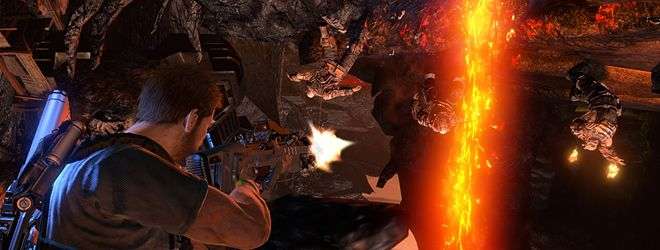





FInally a pretty positive preview among all those being so skeptical! I’m really looking forward to this game, having it pre-ordered already.
You do not happen to know if the multiplayer modes will be playable via splitscreen like the campaign will be?
Great preview Ed. I’m really looking forward to this. Certainly one I want to pick up!
I just can’t wait for this game. Played it twice now, and each time I loved it more than the last… which really is saying something, considering how absolutely shit I am at shooters. I don’t know if it’s because of the anti-grav or just the fact that it’s different in ANY way from other shooters, but I fell in love with it the first time I wandered over to the booth. I’m right behind this game, and hope it lives up to my expectations. So few do :\